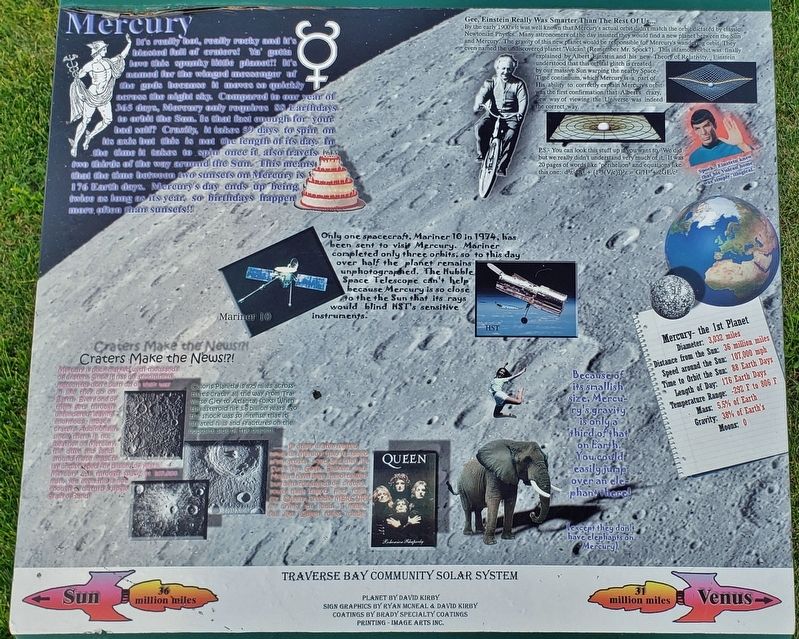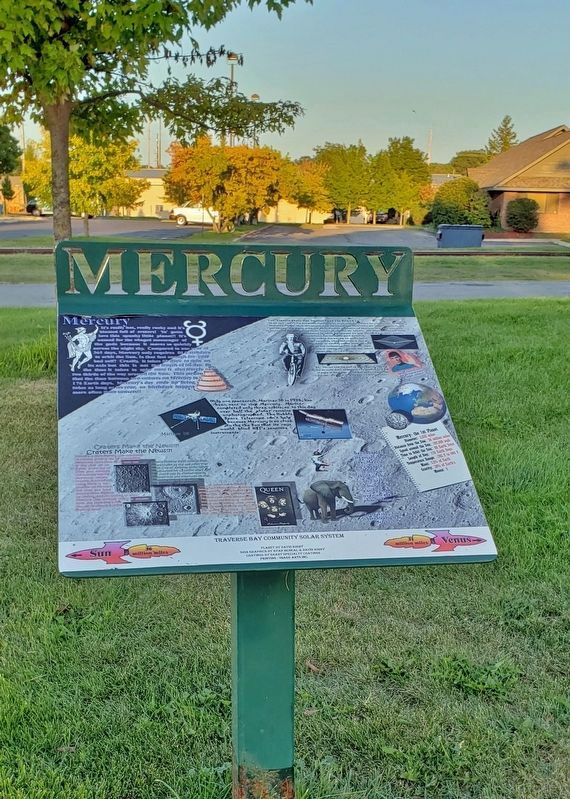Traverse City in Grand Traverse County, Michigan — The American Midwest (Great Lakes)
Mercury
It’s really hot, really rocky and it’s blasted full of craters! Ya’ gotta love this spunky little planet!! It’s named for the winged messenger of the gods because it moves so quickly across the night sky. Compared to our year of 365 days, Mercury only requires 88 Earthdays to orbit the Sun. Is that fast enough for your bad self? Crazily, it takes 59 days to spin on its axis but this is not the length of its day. In the time it takes to spin once it also travels two thirds of the way around the Sun. This means that the time between two sunsets on Mercury is 176 Earth days. Mercury’s day ends up being twice as long as its year, so birthdays happen more often than sunsets!!
Mariner 10
Only one spacecraft, Mariner 10 in 1974, has been sent to visit Mercury. Mariner completed only three orbits, so to this day over half the planet remains unphotographed. The Hubble Space Telescope can’t help because Mercury is so close to the Sun that its rays would blind HST’s sensitive instruments.
Craters Make the News!?!
Mercury is pock-marked with thousands of craters. Since it has no atmosphere, meteorites don’t burn up on their way in like they do on Earth. Every one of them gets through unhindered leaving enormous impact craters. Additionally, since there is no weather on Mercury, the dust and sand around these impacts lay undisturbed for billions of years. Mercury zips through space at 107,000 mph, yet even this is not enough to disturb a single grain of sand!
Caloris Planitia is 875 miles across — that’s crater all the way from Traverse City to Atlanta, folks! When the asteroid hit 3.6 billion years ago the shock was so intense that it created hills and fractures on the opposite side of the planet!!
…In other crater-related news, on Mercury they’re named after artists, poets and their ilk. Sure Van Gogh, Dickens and Mozart have been immortalized but with thousands of craters you’d think they’d find room for Queen’s Freddie MERCURY, fer crying out loud. I mean, cuz like Queen rocks, dude!
Gee, Einstein Really Was Smarter Than The Rest Of Us…
By the early 1900’s it was well known that Mercury’s actual orbit didn’t match the orbit dictated by classic Newtonian Physics. Many astronomers of the day insisted they would find a new planet between the Sun and Mercury. The gravity of this new planet would be responsible for Mercury’s wandering orbit. They even named the undiscovered planet “Vulcan” (Remember Mr. Spock?). This infamous orbit was finally explained by Albert Einstein and his new Theory of Relativity. Einstein understood that this orbital glitch is created by our massive Sun warping the nearby Space-Time continuum, which Mercury is part of. His ability to correctly explain Mercury’s orbit was the first confirmation that Albert’s crazy, new way of viewing the Universe was indeed the correct way.
P.S. — You can look this stuff up if you want to. We did but we really didn’t understand very much of it. It was 20 pages of words like “perihelion” and equations like this one:
Mercury — the 1st Planet
Diameter: 3,032 miles
Distance from the Sun: 36 million miles
Speed around the Sun: 107,000 mph
Time to Orbit the Sun: 88 Earth Days
Length of Day: 176 Earth Days
Temperature Range: -292 F to 806 F
Mass: 5.5% of Earth
Gravity: 38% of Earth’s
Moons: 0
[captions]
• Spock: Einstein knew that his Vulcan home was simply “illogical.”
• Because of its smallish size, Mercury’s gravity is only a third of that on Earth. You could easily jump over an elephant there! (Except they don’t have elephants on Mercury.)
Erected by Traverse Bay Community Solar System.
Topics. This historical marker is listed in these topic lists: Air & Space • Exploration • Science & Medicine.
Location. 44° 45.395′ N, 85° 36.564′
W. Marker is in Traverse City, Michigan, in Grand Traverse County. Marker can be reached from Hannah Avenue just west of Woodmere Avenue, on the left when traveling west. Marker is located along the Boardman Lake Trail in Hull Park. Touch for map. Marker is at or near this postal address: 660 Hannah Avenue, Traverse City MI 49686, United States of America. Touch for directions.
Other nearby markers. At least 8 other markers are within walking distance of this marker. Venus (within shouting distance of this marker); Our Sun (within shouting distance of this marker); Mother Earth (about 400 feet away, measured in a direct line); Mars (about 500 feet away); U.S.S. Sabine Parrott Rifle (approx. half a mile away); Civil War Memorial (approx. half a mile away); Spanish-American War Memorial (approx. half a mile away); World War Memorial (approx. half a mile away). Touch for a list and map of all markers in Traverse City.
Related markers. Click here for a list of markers that are related to this marker. Traverse Bay Community Solar System
Also see . . .
1. Tests of general relativity.
Mercury deviates from the precession predicted from Newtonian effects. This anomalous rate of precession of the perihelion of Mercury's orbit was first recognized in 1859 as a problem in celestial mechanics, by Urbain Le Verrier. Le Verrier suggested that another hypothetical planet might exist to account for Mercury's behavior. The previously successful search for Neptune based on its perturbations of the orbit of Uranus led astronomers to place some faith in this possible explanation, and the hypothetical planet was even named Vulcan. Subsequently, no evidence of Vulcan was found and Einstein's 1915 general theory accounted for Mercury's anomalous precession. In general relativity, this remaining precession, or change of orientation of the orbital ellipse within its orbital plane, is explained by gravitation being mediated by the curvature of spacetime. Einstein showed that general relativity agrees closely with the observed amount of perihelion shift. This was a powerful factor motivating the adoption of general relativity.(Submitted on January 1, 2023, by Cosmos Mariner of Cape Canaveral, Florida.)
2. Vulcan (hypothetical planet).
Vulcan was a theorized planet that some pre-20th century astronomers thought existed in an orbit between Mercury and the Sun. By 1859, the French mathematician Urbain Le Verrier had confirmed unexplained peculiarities in Mercury's orbit and predicted they had to be the result of gravitational influences of another unknown nearby planet or series of asteroids. A French amateur astronomer's report that he had observed an object passing in front of the Sun that same year led Le Verrier to announce the long sought after planet, which he gave the name Vulcan, had been discovered at last. Many searches were conducted for Vulcan over the following decades, but despite several claimed observations, its existence could not be confirmed. The need for the planet as an explanation for Mercury's orbital peculiarities was later rendered unnecessary by Einstein's 1915 theory of general relativity.(Submitted on January 3, 2023, by Cosmos Mariner of Cape Canaveral, Florida.)
Credits. This page was last revised on January 3, 2023. It was originally submitted on January 1, 2023, by Cosmos Mariner of Cape Canaveral, Florida. This page has been viewed 111 times since then and 5 times this year. Photos: 1. submitted on January 1, 2023, by Cosmos Mariner of Cape Canaveral, Florida. 2. submitted on January 2, 2023, by Cosmos Mariner of Cape Canaveral, Florida. 3. submitted on January 1, 2023, by Cosmos Mariner of Cape Canaveral, Florida.


